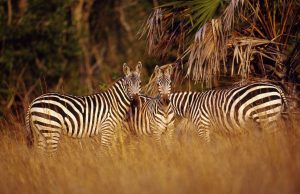
Saadani National Park
A calming coastal breeze blows through the palm trees. Under the tropical heat, white sand and blue ocean glitter seductively. Swahili fishermen cast their nets
The approaching dawn is obscured by swirls of thick mist. The first rays of sunlight cast a reddish halo over the fluffy grasses that are rippling across the plain. At this hour when predators are most active, a herd of zebras strikes a ballerina-like position with their heads in line and stripes blending smoothly.
The surfaced road connecting Dar es Salaam and Iringa passes through Mikumi National Park, which borders the Selous, the largest game reserve in Africa, on its northern boundary. Thus, it is the area of a 75,000 square kilometer (47,000 square mile) wilderness that is most easily accessible. This wilderness area extends almost as far east as the Indian Ocean.
The popular focal point of Mikumi, the Mkata Floodplain, is frequently compared to the more well-known Serengeti Plains because of its expansive vistas and profusion of species. Lions watch over their grassy domain and the migratory herds of zebra, wildebeest, impala, and buffalo from the flat tops of termite mounds, or occasionally, during the rainy season, from perches high in the trees. Giraffes forage in the solitary acacia trees that line the Mkata River; these are the same shade islands that Mikumi’s elephants like.
The Mkata Floodplain, which is crisscrossed by a good network of game watching routes, is maybe the most dependable location in Tanzania for sightings of the mighty eland, the largest antelope in the world. The miombo-covered foothills of the highlands that rise from the park’s boundaries are home to the equally magnificent greater kudu and sable antelope. More than 400 bird species have been identified, with many European migrants arriving during the rainy season to join colorful common residents like the lilac-breasted roller, yellow-throated long claw, and bateleur eagle. Five kilometers north of the main entrance gate, amid a pair of pools, hippos are the main draw, backed by a shifting ensemble of waterbirds.

A calming coastal breeze blows through the palm trees. Under the tropical heat, white sand and blue ocean glitter seductively. Swahili fishermen cast their nets